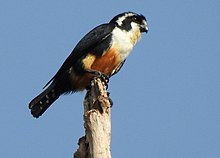The black-thighed falconet (Microhierax fringillarius) is one of the smallest birds of prey, typically measuring between 14–16 centimetres (5.5–6.3 in) long, with a 27–32 centimetres (11–13 in) wingspan, which is a size comparable to a typical sparrow.[2] It is native to Brunei, Myanmar, Thailand, Malaysia, Singapore and Indonesia, and vagrant to Sri Lanka.[1]
| Black-thighed falconet | |
|---|---|

| |
| Scientific classification | |
| Domain: | Eukaryota |
| Kingdom: | Animalia |
| Phylum: | Chordata |
| Class: | Aves |
| Order: | Falconiformes |
| Family: | Falconidae |
| Genus: | Microhierax |
| Species: | M. fringillarius
|
| Binomial name | |
| Microhierax fringillarius (Drapiez, 1824)
| |

| |


Taxonomy and systematics
editThomas Horsfield described to the Linnean Society of London in 1820[3] a Javan variety of Falco cærulescens (the collared falconet). He noted that "the Javan specimens are somewhat smaller, and differently marked" than the Bengal specimen which had been described by John Edwards in 1750. A fuller description was published in his 1824 book, Zoological Researches in Java.[4]
Also in 1824, Auguste Drapiez published the name Falco fringillarius,[5][6]: 412 : plate v and Nicholas Vigors proposed the genus Ierax or Hierax.
Description
editThis is a minute, shrike-like falcon, with a squarish tail that is frequently spread. The adult male is glossy black above, with a white forehead streak that arcs around black cheeks. It has a white or rufous-washed throat, with a white breast shading into a rufous abdomen. Its thighs and flanks are black, as is its cere and legs. In flight the male has white wings underneath with black barring on the primaries and secondary flight feathers, and light streaking on the underwing coverts. There are three white bars underneath on the otherwise plain black tail. The adult female is similar to the adult male, except the tail is longer. The juvenile is similar to the adults, except that the white areas of the head are rufous.[2][7] The voice is a hard, high-pitched cry shiew and a fast repeated kli-kli-kli-kli.[2]
Habitat
editThe typical habitat is forest, forest edge and wooded open area.[1] It can also frequently be found around human cultivation, villages, and near active slash-and-burn forest clearance; often by rivers, streams, and paddy fields. It mostly lives below 1,500m elevation.[2]
Food
editThis falconet mainly feeds on insects, including moths, butterflies, dragonflies, alate termites and cicadas, occasional small birds, and lizards. Feeding behavior appears to often be social, with feeding parties up to ten recorded. Much of the prey is taken during quick flights from a perch.[2]
Sociosexual behaviour and breeding
editThis falconet is generally social and gregarious, often found in loose pairs or groups of ten or more. The breeding season for this falcon varies by location, with populations up to the North of the equator breeding mostly in February–June. To the South of the equator, egg-laying is recorded in Java in November–December.[2] This falconet usually uses old nest holes of barbets, or occasionally old woodpecker holes. No material is added in the cavity aside from insect remains. The typical clutch size is between 2-5 eggs. Incubation and fledging periods are unknown. The nest hole may be used as a roost by adults year-round.[2]
Population
editThere is no data on population densities, but like many tiny falconets, the total numbers are probably under-recorded. The overall range extends more than 1.5 million km². Population assessments vary from common (in Sumatra and Borneo), to fairly common (in Thailand), to scarce (in Java and Bali). In any case, the population seems to be in the upper tens of thousands, and appears to be tolerant of habitat disturbance.[2]
See also
editReferences
edit- ^ a b c BirdLife International (2016). "Microhierax fringillarius". IUCN Red List of Threatened Species. 2016: e.T22696327A93555387. doi:10.2305/IUCN.UK.2016-3.RLTS.T22696327A93555387.en. Retrieved 12 November 2021.
- ^ a b c d e f g h Raptors of the World by Ferguson-Lees, Christie, Franklin, Mead & Burton. Houghton Mifflin (2001)828-829, ISBN 0-618-12762-3
- ^ Section Falco cærulescens, page 135 IA BHL in Horsfield, Thomas (1822). "Systematic arrangement and description of birds from the island of Java. Read April 18, 1820". Transactions of the Linnean Society of London. 13: 135–200. "The drawing of Edwards was made from a bird sent from Bengal. The Javan specimens are somewhat smaller, and differently marked. They appear to form a distinct variety..."
- ^ Horsfield, Thomas (1824). Zoological researches in Java, and the neighbouring islands. London: Kingsbury, Parbury, & Allen. doi:10.5962/bhl.title.44848.
- ^ Sharpe, R. Bowdler (1874). "Microhierax". Volume I: Catalogue of the Accipitres or Diurnal Birds of Prey in the Collection of the British Museum. Catalogue of the Birds in the British Museum. London: Trustees of the British Museum. pp. 366–369.
- ^ Drapiez, Auguste (1824). "Faucon". In Bory de Saint-Vincent (ed.). Dictionnaire classique d'histoire naturelle, vol. 6. Paris: Rey & Gravier. Beagle Library BHL
- ^ Harmer, Sidney Frederic; Shipley, Arthur Everett (1899). The Cambridge Natural History. Macmillan. pp. 173–174. ISBN 978-0-548-64777-6.
External links
editHistorical illustrations
editAlthough most of these illustrations were published with the name Falco cærulescens Linn., Sharpe determined that they represent M. fringillarius (Drapiez). (Catalogue Birds British Museum 1874, v. 1, p. 367)
- Horsfield (1824), Zoological Researches in Java, plate 35. Commons, BHL
- Temminck (1824), Planches Coloriées, plate 97
- Vieillot & Oudart (1825), Galerie des Oiseaux, plate 18. BHL (Uni. Illinois), BHL (Smithsonian)
- Kittlitz (1832), Kupfertafeln zur Naturgeschichte der Vögel, plate 3, fig. 2. IA, BHL, Commons
- Schlegel (1866), De vogels van Nederlandsch Indië, book 3 Valkvogels, plate 2, fig. 1. Google books, Wikimedia Commons, BHL
